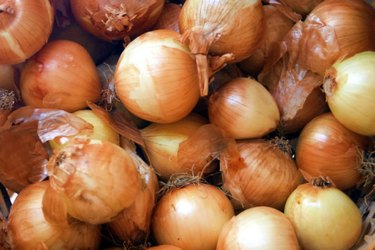
More than a dozen different types of onions are available, including Vidalia, green, and Spanish. Because of this, it is easier to classify onions based on their flavor: sweet or hot. The term "hot onion" is a misnomer, since these onions aren't hot in a spicy sense of the term. They have stronger flavors than sweet onions and are more hardy. Hot onions can be stored for up to six months at a time, whereas sweet onions will need to be eaten within two months of being picked. The best way to tell a sweet onion from a hot one is by examining it closely.
Step 1
Examine the skin of the onion. This is the part that you peel off before getting to the edible part of the onion underneath. The skin on sweet onions is very thin and fragile, and ranges from light tan to pale gold. In contrast, hot onions have dark brown skin that is thicker and tough to peel off.
Video of the Day
Step 2
Remove the onion skin and look at the color of the vegetable. A sweet onion is white or very light gold in color, while a hot onion is a dark yellow.
Step 3
Poke the onion gently with your fingertip and observe any dents left in the onion. The flesh of a sweet onion is also softer and more fragile than the tougher meat of a hot onion. If you fingernail has left an impression, then the onion is sweet.
Step 4
Taste the onion. A sweet onion fulfills its name: it tastes sweet and mild. A hot onion has a stronger, sharper flavor.
Tip
The exception to the rule is red onions, which come in both sweet and hot varieties. The Italian red onion is sweeter than its similarly colored brethren, so check the country of origin when purchasing red onions.
Video of the Day
- What's Cooking America: Onion Myths and Facts
- The Gardener Guido Produce Profile; Getting Sweet on Onions; Mark Ferro; 1996
- The Sweet Onion Source; Welcome to Our Sweet World; 2007
- Onion World; The Call for Validation of What's Being Offered as a "Sweet" Onion; 2005
- National Onion Association; About Onions: Seasonality; 2009
- "Chow": Onions